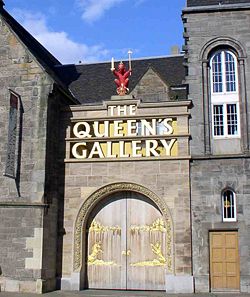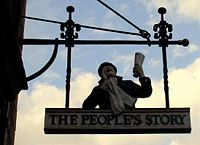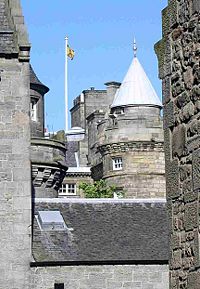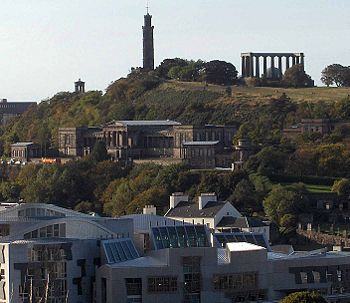Edinburgh/External Links
Jump to navigation
Jump to search

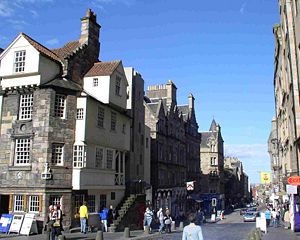
- Please sort and annotate in a user-friendly manner and consider archiving the URLs behind the links you provide. See also related web sources.
Museums and galleries
- Adjacent to Holyrood Palace, the Queens Gallery displays exhibitions of art from the Royal Collection.
- Edinburgh CastleOne of the UK's leading tourist attractions, the Castle's features include St Margaret's Chapel - Edinburgh's oldest building, dating from the 1100s; Crown Square - the main courtyard, developed in the 15th century; The Great Hall with a hammerbeam roof built by James IV; The Half Moon Battery, from the late 16th century; and The Scottish National War Memorial added after the First World War. The Edinburgh Military Tattoo is held each August in the esplanade outside the Castle.
- The City of Edinburgh Museums and Galleries Includes information on The Museum of Childhood and The Writers' Museum.
- The National Galleries of Scotland
- National Museum of Scotland Chambers' Street
- National War Museum at Edinburgh Castle
- National Museums Collection Centre Granton
- Surgeons' Hall Museums Royal College of Surgeons of Edinburgh, Nicolson Street
- City Art Centre Holds the City's collection of Scottish Art, and hosts temporary exhibitions.
- Georgian House at 7 Charlotte Square. Owned by the National Trust for Scotland. One of Robert Adam's designs for Charlotte Square, considered a masterpiece of urban architecture, and now restored as a typical 1790-1810 mansion. China, silver, paintings and furniture are on display.
- Gladstone’s Land, in the Lawnmarket, Royal Mile. Owned by the National Trust for Scotland, this is the 17th century tenement home of an affluent merchant.

(CC) Photo: Citizendium
John Knox House consists of two town houses (or "lands") with the earlier part constructed about 1470 as part of the redevelopment of the city's walls. The exterior of the front house is much the same as that created in 1560.
John Knox House consists of two town houses (or "lands") with the earlier part constructed about 1470 as part of the redevelopment of the city's walls. The exterior of the front house is much the same as that created in 1560.
- John Knox House
- The Leith Gallery Scottish contemporary art
- Royal Botanic Gardens founded in 1670 and moved to its present location in Inverleith in 1820.
- The National Gallery Designed by William Playfair, this is one of the finest galleries in Britain, containing works by Tintoretto, Titian, Poussin, Claude Lorraine, Rembrandt, Reynolds, Gainsborough, Chardin, Antonio Canova and Turner, as well as French Impressionists, and Scottish artists.
- Lady Stair’s House/Writer’s Museum on the Royal Mile, displays manuscripts, relics and memorabilia of Robert Burns, Sir Walter Scott and R.L. Stevenson.
- The Fruitmarket Gallery Changing international exhibitions of contemporary art, in the former Fruit Market south of Waverley Station in the center of Edinburgh.
- The Museum of Edinburgh, formerly known as Huntly House, occupies 16th and 17th century buildings in the heart of the Old Town. Exhibits include:the feeding bowl and collar belonging to Greyfriars Bobby; the National Covenant, the petition for religious freedom signed by Scotland’s Presbyterians in 1638; and the original plans for Edinburgh’s New Town drawn by architect James Craig.
- The Museum of Childhood on the Royal Mile, displays toys, costumes, books, dolls and games.
- National Portrait Gallery Queen St. Among the portraits on display are Allan Ramsay’s portrait of the philosopher David Hume, Alexander Nasmyth’s portrait of Robert Burns and Sir Henry Raeburn’s portrait of Sir Walter Scott.
- National Library of Scotland on George IV Bridge holds over 8 million books, thirteen million printed items and more than 1.6 million maps. The collection includes copies of the Gutenberg Bible, the original manuscript of Charles Darwin's Origin of Species, and Scotorum historiae a prima gentis origine (Hector Boece, 1527): the first printed book dedicated to the history of Scotland.
- The People's Story is housed in the late 16th century Canongate Tolbooth opposite the Museum of Edinburgh, on The Royal Mile. ' The People's Story ' uses oral history, reminiscence, and written sources to tell the story of the lives, work and leisure of the ordinary people of Edinburgh, from the late 18th century to the present.
- Mary King Close
- The Royal Scottish Academy
Tourist attractions
- Edinburgh and the Lothians Tourist Board
- Greyfriars Kirk
- Edinburgh's Flodden Wall (Old Town)
- A Tour of the City of Edinburgh from The Department of Geography at The University of Edinburgh
- the Palace of Holyroodhouse, founded as a monastery in 1128, is The Queen's official residence in Scotland. Mary, Queen of Scots lived here between 1561 and 1567. Today, the Palace is the setting for State ceremonies and official entertaining, and is open to the public when the Queen is not in residence there. Near the Queen's supper room, a brass tablet in the floor marks where the body of David Rissio, Queen Mary's secretary, was left after being stabbed repeatedly by several nobles. In 1745 the Palace was occupied by Prince Charles Edward Stuart (Bonnie Prince Charlie), the last Stuart to reside there.
- Holyrood Park (also known as the Queen's Park, because it is owned by the Queen) is probably the largest area of natural landscape remaining in the centre of any European city. The Park's 650 acres contains Arthur's Seat, Dunsapie Loch, the ancient ruin of St. Anthony's Chapel, and the Salisbury Crags.
- The Royal Observatory on Calton Hill
- Dynamic EarthVisitor attraction run by a charitable trust committed to the education and lifelong learning of Earth sciences
- The Scott Monument on Princes St. is a 200 ft. high neo-Gothic spire commemorating the poet and novelist Sir Walter Scott(1771-1832) with 64 statuettes of Scott's novels' characters. Four viewing platforms (287 steps by narrow stairs to the top) allow dramatic views of Edinburgh. Scott's novels were enormously popular in the early 19th century, and he is said by some modern scholars to have had a seminal influence on the development of the European novel genre, but his popularity with readers had declined markedly by the end of the 19th century and never recovered. The Monument, designed by self-taught architect George Meikle Kemp, was built between 1840 and 1846.
- Scotch Whisky Heritage Centre on the Royal Mile is an exhibition about the whisky making process.
- Nelson's Monument on Calton Hill is a 106 ft. tall, tiered, circular tower with viewing gallery overlooking the city. It commemorates Admiral Lord Nelson's victory and death at the battle of Trafalgar on 21 October 1805.
- The Royal Yacht Britannia is moored at Ocean Terminal, Leith. The Royal Yacht Britannia was launched at John Brown's Shipyard in Clydebank in 1953. From then until her last voyage in 1997, the Royal Yacht carried The Queen and the Royal Family on 968 official voyages.
- The Edinburgh Dungeon is one of Edinburgh’s more unpleasant tourist “attractions”, displaying instruments of torture, and relating tales of horror and cruelty with gleeful prurience and a cavalier disregard for historical veracity.
- Edinburgh Zoo, opened in 1913, is in Corstorphine. Owned by the Royal Zoological Society of Scotland, its best known attractions are its penguins. This was the first zoo in the world to house and to breed penguins; every afternoon, at about 2 p.m., about two dozen Kings, Rockhoppers, Macaronis and Gentoos go for a walk around the Zoo (voluntarily, but accompanied by keepers).
- Camera Obscura and World of Illusions on Castlehill
- Jenner's Department Store on Princes Street. The exterior of the late Victorian building is encrusted with ornate carved stonework.
- Anatomical Museum - hosts the skeleton of William Burke
- Gilmeton Cove A network of underground tunnels dating from at least the early 18th century.
Just outside Edinburgh
- Lauriston Castle
- Roslin Chapel, particularly popular with tourists since the success of the novel The DaVinci Code and the subsequent movie.
- Hopetoun House; a stately home, part built between 1699 and 1702 and part designed between 1720 and 1750 by the Adam brothers (William, Robert and John)
- Inchcolm Island and Abbey; medieval abbey, founded in 1123
- Bass Rock, a sea-bird sanctuary in the Firth of Forth two miles east of North Berwick, holding approximately 10% of the world population of North Atlantic Gannets. The first inhabitant of Bass Rock was Baldred, a monk of Lindisfarne who was sent to the Lothians in the 8th century to convert its heathen inhabitants to Christianity. In the 15th century, King James I imprisoned political enemies on the Bass Rock, including, in 1428, 14 year-old Neil Bhass Mackay After the murder of King James in 1437, Neil escaped and was proclaimed 8th Chief of the Clan Mackay. In the early 16th century, Mary Queen of Scots kept a garrison of 100 men, including some French troops, stationed on the rock. A small chapel on the Rock was built around 1491 and dedicated to Saint Baldred in 1546.
- The Forth Bridge This dramatic Railway Bridge spanning the Firth of Forth was the world’s first major steel bridge, with girder spans of 521 m (1710 ft). Begun in 1883, it was opened on 4 March 1890 when Edward, Prince of Wales tapped a ‘golden’ rivet into place.
- Deep Sea World, situated underneath the Forth Rail Bridge.
Theatres
- Edinburgh Theatres website
- The Royal Lyceum Theatre
- Assembly Theatre
- Pleasance Theatre
- The King's Theatre
- The Festival Theatre
- The Edinburgh Playhouse 3000-seats; musicals
- The Traverse Theatre New writing theatre
- The Usher Hall Concert Hall; Edinburgh's main venue for classical music.
- The Scottish Storytelling Centre on the Royal Mile. Opened in 2006, the Centre incorporates a Cafe, Theatre, Storytelling Court and Library.
- Other major venues for music and theatre include The Hub (in the Old Town), the Assembly Rooms and the Queen's Hall. The Scottish Chamber Orchestra, formed in 1974, is based in Edinburgh.
Entertainment
- The List is a fortnightly events guide for Edinburgh and Glasgow (weekly during the Edinburgh Festival). Founded in 1985, its registered office are just off the Royal Mile. Its reviews and listings include film, music, books, comedy, clubs, art, sports, and restaurants.
- Edinburgh's festivals BBC Newsguide to the many festivals which occur throughout the summer.
- The Royal Edinburgh Military Tattoo
Information
- City of Edinburgh Council
- Capital Review Economic Data
- City of Edinburgh Population and Demographic Information
- Edinburgh - Inspiring Capital,introduction to Edinburgh City Region
- Edinburgh - The official Tourist Board
- Edinburgh : UNESCO City of Literature website
Hotels
- The George, designed by Robert Adam
- The Balmoral Hotel, at the east end of Princes Street was built originally as the North British Hotel for the railway company which used Waverley Station. It opened on October 15, 1902. The clock is traditionally kept two minutes fast to help tardy travellers catch their train.
- The Caledonian Hotel, at the west end of Princes Street was, like the Balmoral Hotel at the other end of Princes Street, built by a long-gone railway company, in this case the Caledonian Railway.
Pubs
They include:
- The Last Drop in the Grassmarket, opposite the former site of the public scaffold.
- The Blind Poet Close to the home of Thomas Blacklock
- The World's End, focus of a notorious murder case
- Jekyll & Hyde
- Maggie Dickson's Pub on the Grassmarket; on 2 September 1724 (by some accounts; given dates vary), Maggie Dickson was hanged at the Grassmarket for infanticide. When her body was being taken for burial, noises were heard coming from the coffin - she had miraculously survived, and lived for at least a further 35 years, with the nickname "Half Hangit Maggie".
- Jenny Ha's on Canongate. In 1681, the first "international" golf match took place on Leith Links to settle an argument; it was between two English nobles and a Scottish team comprising the Duke of York (the future James VII), and John Paterson, a mere cobbler. The English did not know that Paterson was already known as an outstanding golfer, and with his involvement, the result was in no doubt. Paterson was duly rewarded by the Duke of York, enabling him to buy a tenement on Canongate that he called 'Golfer's Land'. This was demolished in 1960, to make way for the (dismally ugly) building of which Jenny Ha's is a part.

